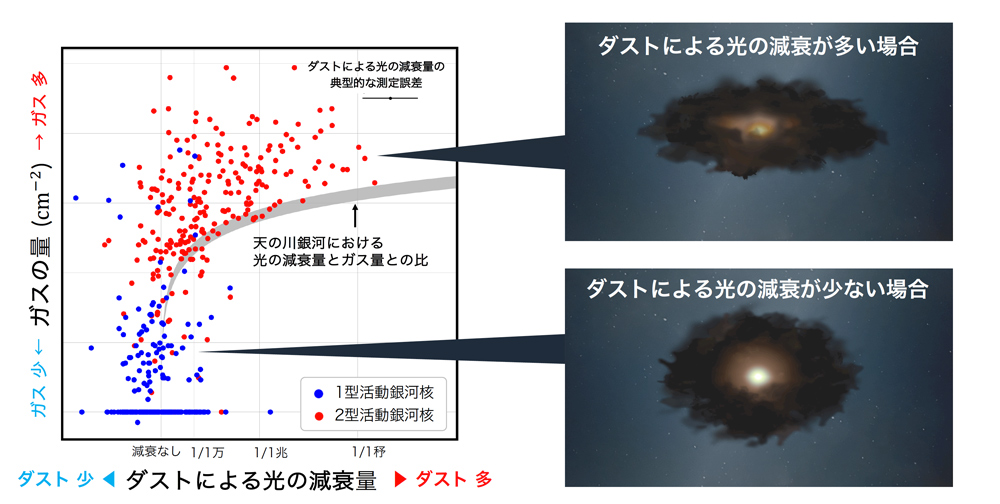Disclaimer: machine translated by DeepL which may contain errors.
Capturing the Black HoleHidden in the Dust
Shoichiro Mizukoshi (First-year doctoral student, Department of Astronomy )Takeo Minezaki (Associate Professor, Institute of Astronomy ) |

![]()
In May 2022, the international radio observation project EHT (Event Horizon Telescope) captured the image of a giant black hole at the center of our Milky Way Galaxy. Although giant black holes have become familiar to us, we still do not know how they have grown and how they are related to the growth of galaxies.
Active galactic nuclei are in the process of sucking in matter into a massive black hole, and are the very site where the black hole is growing. On the other hand, active galactic nuclei emit intense light comparable to that of an entire galaxy, even though their spatial scale is about 10 orders of magnitude smaller than that of a galaxy. This intense light blasts the material around the active galactic nucleus into the galaxy, resulting in environmental changes in the galaxy. Thus, active galactic nuclei are a key phenomenon in the search for giant black holes and galaxy growth.
In active galactic nuclei, a structure of gas containing "dust" (called "dust" in astronomy) surrounds the central black hole and obscures the central region. The amount of light attenuation due to this dust structure varies depending on the viewing angle, which is important information for investigating the nature of the dust structure. Until now, the amount of light attenuation has been estimated mainly from visible light observations. However, the visible light is efficiently attenuated by the dust, so the value could not be estimated for active galactic nuclei deeply hidden in the dust.
Therefore, we have developed a new method to estimate the light attenuation using near-infrared light, which is less sensitive to dust attenuation than visible light. Since the attenuation of light due to dust is smaller at longer wavelengths, the more dust there is, the darker and "redder" the light is. Therefore, the amount of light attenuation due to dust can be estimated by measuring how much the observed light becomes "redder". The problem here is the contamination of radiation emitted by stars in galaxies with active galactic nuclei. The present method solves this problem by focusing on the variation width of the time-varying emission peculiar to active galactic nuclei.
The results of applying this method to active galactic nuclei of 463 sources, which include both objects with little or no attenuation in visible light and objects with attenuation (Type 1 and Type 2 active galactic nuclei, respectively), show that the light attenuation of Type 2 active nuclei is distributed over a wide range, with a maximum of about 24 orders of magnitude (1 in 1 ???? 1 in 1 trillion = one trillionth of a trillion) of the visible light attenuation. In addition, a comparison of the amount of gas (mainly composed of hydrogen) in the line of sight estimated from X-ray observations and the amount of light attenuation shows that the amount of gas to dust is higher in these objects than in the Milky Way Galaxy for a larger number of objects than before. In the future, we would like to apply this method to more objects to understand the detailed structure of active galactic nuclei and the growth of active galactic nuclei and galaxies.
The results of this study were published in S. Mizukoshi et al. MNRAS, 516, 2876 (2022).
(Press release, September 16, 2022)
Published in Faculty of Science News, January 2023
Communicating to Faculty Research Students >



